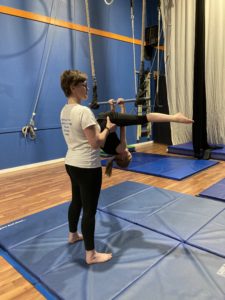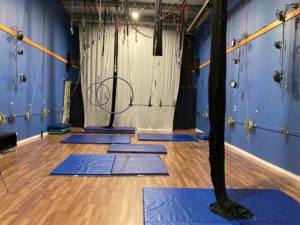In Aerial Training, Slow and Steady Wins the Race: A Q/A with Spectacle Blue
Whether you’re on the studying or the teaching end, aerial training is hard work… but with enough time and support, you’ll have no problem helping young circus students learn to fly. Spectacle Blue‘s Robin Szuch breaks down the school’s philosophy on training the next generation of aerial instructors.
Even for the highest-flying aerialists, soaring around the venue is no simple feat. Unlike wrens or ravens, people are not built for flight; we need the right tools to achieve it—the right kinds of instruction, and of instructors. Enter Robin Szuch.
An aerial instructor and past performer herself, Robin comprises half of the duo behind Spectacle Blue, an Alberta-based school and studio space that extends the aerial chain by offering training for both circus students and their instructors. Since its 2014 founding, Spectacle Blue has worked with Canadian teachers from disciplines within and beyond circus to help them establish their own aerial training practices through a carefully planned course that’s packed with safety tips, support, and research-backed techniques to let them and their students soar. Robin knows that experience matters, that patience is a teacher’s greatest virtue in the classroom—that taking one’s time with students can make all the difference.
We caught up with Robin to ask about Spectacle Blue’s philosophy on teaching and on aerial arts, as well as more specifics about the training program. Here’s what she had to say:
CircusTalk (CT): How did you come up with this training program?
Robin: When I retired from being a full-time performer and returned to my roots in youth training, I saw a real hole in pedagogical training in aerial for youth. There were programs popping up everywhere, not just in circus-specific facilities, but also in dance studios and gymnastics clubs. There were training programs out there geared towards adult students, or students that already had a baseline of skills, but nothing to get kids and teens safely to those more advanced programs. As a progressional step-by-step learner myself, I realized I was in a unique position to build a pedagogical program to help teachers and coaches train their students with safe, progressional programming.

CT: Who specifically are you targeting with the course?
Robin: This program is designed for gymnastics coaches, dance teachers, circus instructors, school educators— really, it is for anyone who wants foundational, progressional programming for their students. Whether their goals for their students are learning new skills for fun in a once-a-week scenario or training them to grow into professional performers, the program provides awesome progressions for students and sound safety and spotting techniques for teachers.
CT: Tell us more about the course’s syllabus and what it offers. What are the main areas of focus? How much of a time commitment does it require from teachers and participants?
Robin: The program is divided into three Modules for teachers and nine Grades for students. Module One focuses on the foundations: rigging, spotting techniques, classroom management, and then, of course, the material for Grades One, Two, and Three. We cover three apparatus in our programming, Trapeze, Hoop, and Silks. Each Grade is divided into three main training foci including strength, flexibility, and then aerial elements. I strongly believe that well-rounded training is about more than achieving a “trick”; I believe in having the strength to control each element so students are never ‘throwing” themselves into them; the strength-based flexibility to have full control over their movement; and then, of course, the safe practice of each aerial element.
Module Two includes a review of rigging and spotting techniques: the most important tools in the teacher’s toolbox. From there we advance to the Grades Four, Five, and Six material in all three apparatuses. Here we also teach studio and classroom culture as well as partner work.
Module Three again reviews the rigging and spotting techniques and then dives into the Grades Seven, Eight, and Nine material. At this point, teachers, and their students back at their facilities, should be gaining a more solid understanding of the progressions involved in each element so they are now able to create variations on technical elements. In Module Three we work on improvisational concepts as well as creative processes.

Each Teacher Training Module is a two-day course followed by a full-year mentorship. I want teachers to run safe programming. I want students to advance with solid foundations. That means that it is our job as trainers of teachers to provide them a place to ask questions and get answers without having to guess. We have coaches, teacher trainers, choreographers, and riggers on staff that are ready to help our teachers run their best programs per the best practices. We also have an online video manual included as a part of the course offerings, and offer teachers who have taken a Module the chance to take one free refresher course with us. If they need a brush-up, we are here to help. Again, our focus is on strong pedagogical coaching with safety built in, so we need to build strong, knowledgeable teachers.
CT: How does the program’s approach differ for dance teachers vs. gymnastic coaches?
Robin: There is no difference. Strong foundations in aerial are important no matter the environment the classes are being offered in. Circus aerial, although having some similarities to dance, acrodance, and gymnastics, is its very own discipline. Students and teachers with an understanding in these other disciplines already understand their bodies in space and the importance of line and technique, but aerial is its own discipline that requires its own pedagogical training program.
CT: What makes this course most of value for the participants? What can they expect to take away from it?
Robin: Teachers leave our program knowing that they have not only the tools they need to create a safe, progressional, well-rounded program at their facility, but also, that they are not alone. This is not a course where you take the training and are left to figure it out on your own. We are here for you every step of the way with our full-year mentoring component after every module.

CT: What are you most proud of as it relates to this program?
Robin: I love the relationships we have built with our teachers that have come through the program. The mentorship we offer is what sets us apart. I really do believe that aerial is amazing work for kids and love how it’s growing and being offered in so many different kinds of facilities.
That being said, I also believe we need to do better to ensure the safety of our programs and our students. At Spectacle Blue Aerial Teacher Training, we have a strong pedagogical program that helps take the fear out of running a program and the support system to keep those programs safe as well as fun.
Psst… want to try your own hand at aerial? Keep an eye out for Spectacle Blue’s next teacher training course, or reach out to the team directly through their website. When learning to fly, it’s never too late to get a running start!
All images shared by Robin Szuch...
Do you have a story to share? Submit your news story, article or press release.





